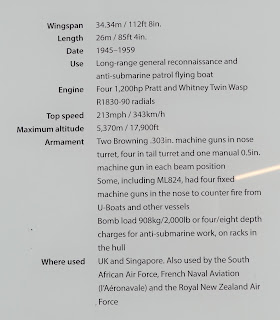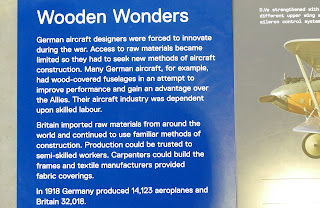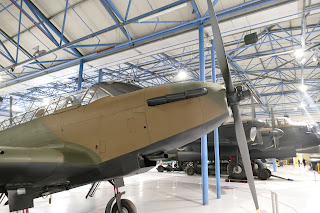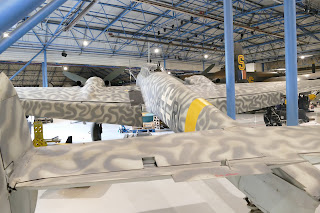Hello There! Here are some photographs from a visit to the RAF Museum at Hendon. I had dropped my daughter off at University and driven past the signs to the museum a few times but never had the opportunity to visit.
The entrance to the museum has a number of exhibits which are a combination of World War One aircraft but also displays of the work of the Royal Air Force today.
I have heard of the caterpillar club and goldfish club but never seen a badge. I have seen them on programmes like the Antiques Roadshow but not for real.
Anyone who has seen any documentaries about Colditz would know about some of these inventions but it is something to see them for real!
The first metal model I got from MMS Model was one of these! I still have it and I like to get it on the table regularly. I was thinking when I bought it in the '90's that a recce game would be more interesting that seeing wall to wall tanks moving around in a phalanx.
An absolutely massive aircraft. It looked so much bigger contained in a hangar. This of course makes you think of the Airfix model of this too.
Although this also made me think of the RAF Rescue launch from Airfix this is a later version used after World War Two
The Zeppelins remind me that my home town of Great Yarmouth was victim to one of the first air raids and has the first house to be damaged in an air raid, which was situated at the top of the road I lived in. It has been rebuilt and has a plaque over the front door.
This exhibit showed the mechanics of the machine gun that could fire through the propeller of an aircraft with out shooting the props of the propeller. This was a bit mesmerising!
The Lewis gun looked so basic that you could be excused for thinking it was incomplete!
The paint scheme that is the bane of all modellers! I would not buy such a model because of that scheme alone!
Being able to get up close to some of the aircraft gave you the chance to see how they were built and see how flimsy they really were! This seemed to be made from thin plywood.
When you see the aircraft that was flying when you were in the forces, hanging up in a museum it makes you feel old. Almost certainly one from Coltishall, where I was based.
You could climb up some steps to have a closer look at the Tornado. When I was at infants school this was called the MRCA, (multi role combat aircraft), and was pictured in red and white prototype colours. Now it is in a museum!
Here is the latest aircraft in use in the RAF.
This buccanear has a cartoon on the side, something many of the Coltishall Jaguars had during the first Gulf War. My first job when Kuwait was invaded was to start degreasing the aircraft ready to be painted the next day.
Another first for me. One of the first Airfix aircraft models I ever painted.
While the Auster that Airfix did was a snow version you could make do for the wargaming table with it. However does the crosshatching beams on the roof trusses mean they are World War One vintage?
Again to see one of these up close you realise that the fuselage is very big and chunky.
A precursor of the Hurricane. This hangar was full of many aircraft I have not seen, even after a number of visits to Duxford!
A mixture of pictures of the ThunderBolt again, a Typhoon and a recovered Gloster Gladiator.
I have never seen a Beaufighter or a Beaufort before either! The Beaufighter was another Airfix kit completed as a child.
Some views of a Leigh Light which was strapped to Coastal Command aircraft to spot German U boats charging their batteries on the surface of the water.
This Lockheed Hudson has no red in the centre part of the roundel so that in the Pacific it cannot be mistaken for a Japanese aircraft from a distance.
These Battle of Britain exhibits speak for themselves but did not know that some Italian aircraft were involved in the Battle as well.
One of the first wire guided bombs built. This German version was an anti ship weapon. this is the sort of thing that sunk an Italian battleship as it was surrendering to the allies in 1943
I remember reading about the fuel in this was so corrosive that one pilot was dissolved alive when the trailer that departed from the aircraft on take off punctured a fuel line.
Matchbox did a very sturdy model of this and that stood on the shelf in my bedroom for a very long time.
A Salamander. I remember seeing one of these at Duxford, perhaps it is the same one, on a visit?
Amazing that one of these has survived. The Germans made short work of these in France in 1940.
A German ME 110. A classic and part of a 'Dogfight Double' from Airfix too.
A Mosquito! Well that was a surprise. I hear that somewhere in the World there is a flying one of these now?
Now we are talking! One of the things I had specifically come to see. Not as big as I thought in real life but still impressive.
Recovered from the bottom of a fjord. This is in poor condition but who knows what will happen to this?
Tucked away and not easy to get to, this FW190 had the wings removed.
A second 'must see'. The Stuka was a big meaty plane but the fact it was so slow and lumbering if caught in the open it did not last long!
A Queen Mary Trailer, another Airfix memory.
I serviced bomb trailers like that when I was in the RAF!
The last few photographs are a mix of a Japanese plane, (?), a Liberator, a Lancaster and a ME109.
A thoroughly enjoyable visit. If it rains much of the museum is under cover, so you do not get soaked. Also some of the building are original and the first hangar dates to the First World War. The odd exhibit is a bit tatty but the majority are pristine.
The cafe was actually quite good as well, as usually it is an after thought. Highly recommended.






















































































































































































































































Very interesting! Thanks for sharing!
ReplyDeleteBest wishes,
Jan
That's a helluva day out, mate! Lots to see there. Wish I'd been along.
ReplyDelete